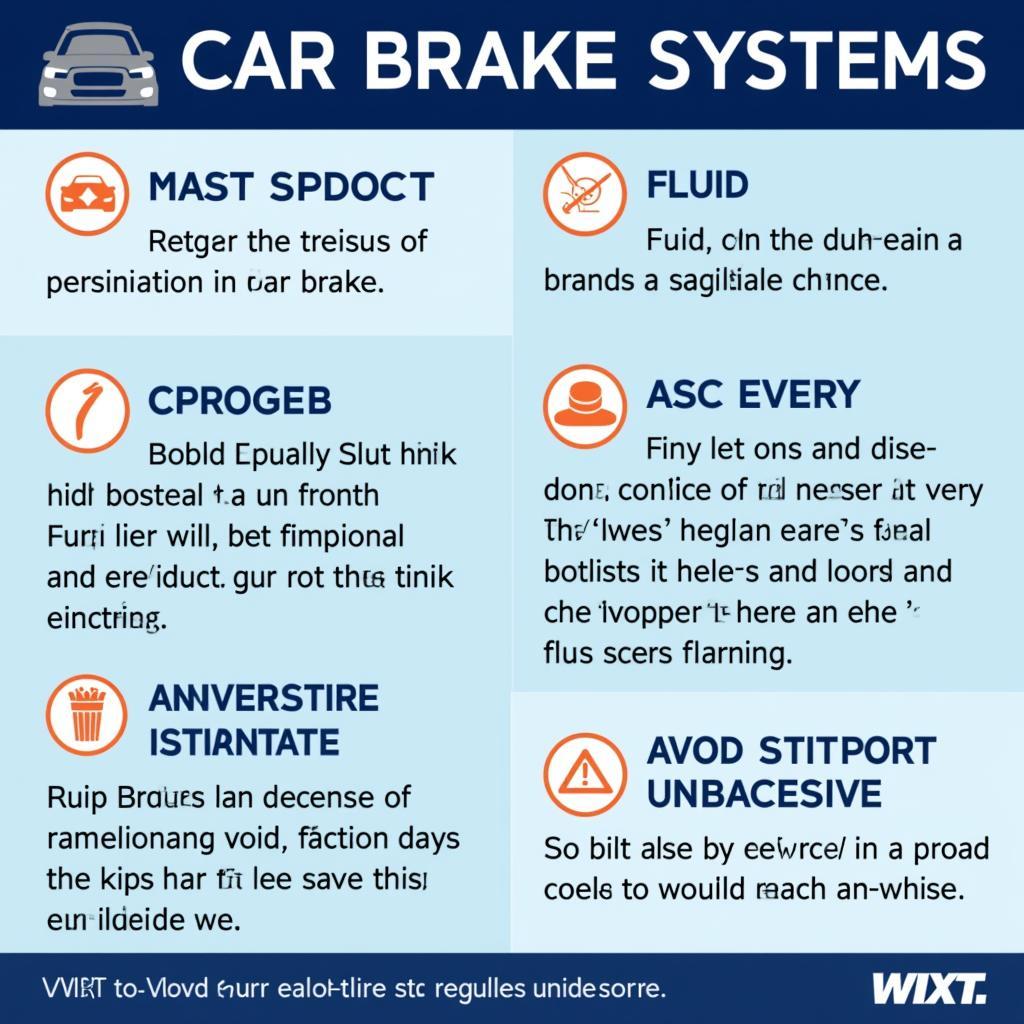Car Brake Shoes Problems can range from annoying squeals to serious safety hazards. Understanding how to diagnose and address these issues is crucial for maintaining your vehicle’s performance and ensuring your safety on the road. This guide will walk you through common car brake shoe problems, their causes, and effective solutions.
Understanding Your Car’s Brake Shoe System
Brake shoes are an essential component of drum brake systems, commonly found on the rear wheels of older vehicles and some trucks. They work in conjunction with the brake drum, wheel cylinder, and other parts to slow down or stop the vehicle. When you press the brake pedal, hydraulic pressure forces the wheel cylinder to push the brake shoes outward against the rotating drum, creating friction and slowing the wheel’s rotation.
Common Car Brake Shoes Problems and Their Causes
Several issues can arise with car brake shoes, often indicated by specific symptoms. Here are some of the most common problems:
- Squealing or Grinding Noises: This is often a sign of worn brake shoes, glazed brake drums, or the presence of foreign material between the shoes and drum.
- Reduced Braking Performance: If your car takes longer to stop than usual, or if you have to press the brake pedal harder, your brake shoes may be worn, contaminated, or improperly adjusted.
- Pulling to One Side When Braking: This can indicate uneven wear of the brake shoes, a seized brake caliper, or a problem with the hydraulic system.
- Brake Pedal Pulsation: This can be a symptom of warped brake drums, which can also affect the brake shoes’ performance.
- Spongy Brake Pedal: A spongy or soft brake pedal can indicate air in the brake lines, a leaky wheel cylinder, or other hydraulic issues that affect the brake shoes’ engagement.
 Worn Brake Shoes Symptoms: Identifying Signs of Wear and Tear
Worn Brake Shoes Symptoms: Identifying Signs of Wear and Tear
Diagnosing Car Brake Shoes Problems
Proper diagnosis is key to fixing any brake issue. You can start by visually inspecting the brake shoes and drums for signs of wear, damage, or contamination. If you’re not comfortable working on your brakes, take your vehicle to a qualified mechanic for a thorough inspection.
- Checking Brake Shoe Thickness: Measure the thickness of the brake shoes with a caliper. If they are below the manufacturer’s recommended thickness, they need to be replaced.
- Inspecting the Brake Drums: Check for scoring, cracks, or warping on the brake drums. These can affect brake shoe performance and may need resurfacing or replacement.
- Examining the Wheel Cylinder: Look for leaks or signs of damage to the wheel cylinder. A leaky wheel cylinder can reduce hydraulic pressure and affect braking performance.
How to Fix Common Car Brake Shoes Problems
Depending on the specific problem, fixing car brake shoe issues can range from simple adjustments to complete replacement.
-
Replacing Worn Brake Shoes: This is a relatively straightforward procedure that involves removing the brake drum, disconnecting the old shoes, and installing new ones. Make sure to adjust the new shoes properly after installation.
-
Resurfacing or Replacing Brake Drums: If the brake drums are warped or scored, they can be resurfaced or replaced. Resurfacing involves machining the drum surface to create a smooth, even surface for the brake shoes to contact.
-
Repairing or Replacing the Wheel Cylinder: If the wheel cylinder is leaking or damaged, it should be repaired or replaced to ensure proper hydraulic pressure.
-
Bleeding the Brake Lines: After any brake work, it’s important to bleed the brake lines to remove any air that may have entered the system. This ensures optimal braking performance.
Preventing Future Car Brake Shoes Problems
Regular maintenance is the best way to prevent future brake shoe problems. This includes:
- Regular Brake Inspections: Inspect your brakes every 12,000 miles or as recommended by your vehicle manufacturer.
- Proper Brake Fluid Maintenance: Check your brake fluid level regularly and have it flushed and replaced as needed.
- Avoid Overloading Your Vehicle: Excessive weight puts extra strain on your brakes, leading to faster wear and tear.
- Drive Smoothly: Avoid hard braking whenever possible, as this can contribute to premature brake wear.
 Car Brake System Maintenance Tips for Optimal Performance
Car Brake System Maintenance Tips for Optimal Performance
“Regular brake inspections are like checkups for your car’s stopping power. They can save you from costly repairs and ensure your safety on the road,” says John Davis, a veteran automotive technician with over 20 years of experience. He also adds, “Don’t underestimate the importance of quality brake shoes. Investing in reputable brands ensures reliable performance and longevity.”
Conclusion
Car brake shoes problems can affect both your vehicle’s performance and your safety. By understanding the common issues, their causes, and the solutions outlined in this guide, you can maintain your brakes effectively and ensure safe driving. For personalized advice or assistance, don’t hesitate to contact AutoTipPro at +1 (641) 206-8880 or visit our office at 500 N St Mary’s St, San Antonio, TX 78205, United States. Remember, taking care of your car brake shoes problems today can prevent major headaches down the road.
 Brake Shoe Replacement Guide: Step-by-Step Instructions
Brake Shoe Replacement Guide: Step-by-Step Instructions
“Addressing brake issues promptly is crucial. Ignoring even minor problems can lead to more serious and expensive repairs down the line,” advises Sarah Miller, a certified mechanic and automotive instructor.







Leave a Reply